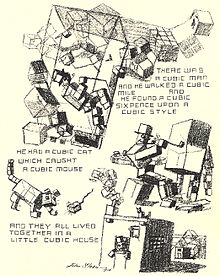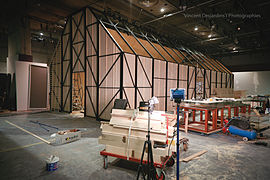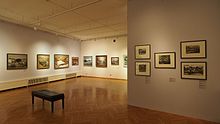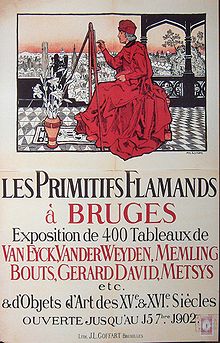Letter to Students About Art Work Chosen for Art Show

An fine art exhibition is traditionally the space in which fine art objects (in the nigh full general sense) meet an audition. The exhibit is universally understood to be for some temporary period unless, as is rarely truthful, it is stated to exist a "permanent exhibition". In American English, they may be called "exhibit", "exposition" (the French give-and-take) or "evidence". In United kingdom of great britain and northern ireland English, they are ever called "exhibitions" or "shows", and an individual item in the testify is an "exhibit".
Such expositions may present pictures, drawings, video, sound, installation, performance, interactive fine art, new media art or sculptures past individual artists, groups of artists or collections of a specific form of art.
The fine art works may be presented in museums, art halls, art clubs or private art galleries, or at some place the principal business of which is not the display or sale of art, such equally a coffeehouse. An important distinction is noted betwixt those exhibits where some or all of the works are for sale, normally in private art galleries, and those where they are not. Sometimes the outcome is organized on a specific occasion, like a birthday, anniversary or commemoration.
Types of exhibitions [edit]

There are different kinds of art exhibitions,[1] in item there is a distinction between commercial and non-commercial exhibitions. A commercial exhibition or trade off-white is oftentimes referred to as an fine art off-white that shows the piece of work of artists or art dealers where participants by and large have to pay a fee. A vanity gallery is an exhibition infinite of works in a gallery that charges the artist for use of the infinite. Temporary museum exhibitions typically brandish items from the museum'southward ain collection on a particular period, theme or topic, supplemented by loans from other collections, mostly those of other museums. They usually include no items for sale; they are distinguished from the museum's permanent displays, and nearly big museums set aside a infinite for temporary exhibitions.
Exhibitions in commercial galleries are often entirely made upwardly of items that are for auction, but may be supplemented by other items that are non. Typically, the visitor has to pay (extra on top of the basic museum entrance toll) to enter a museum exhibition, merely not a commercial i in a gallery. Retrospectives await back over the work of a single artist; other common types are individual exhibitions or "solo shows", and group exhibitions or "group shows"). The Biennale is a large exhibition held every two years, oft intending to gather together the all-time of international art; at that place are now many of these. A travelling exhibition is an exhibition seen at several venues, sometimes across the world.
Exhibitions of new or recent art tin exist juried, invitational, or open.
- A juried exhibition, such as the Royal Academy Summer Exhibition in London, or the Iowa Biennial, has an individual (or group) acting as estimate of the submitted artworks, selecting which are to be shown. If prizes are to exist awarded, the judge or panel of judges will unremarkably select the prizewinners every bit well.
- In an invitational exhibition, such equally the Whitney Biennial, the organizer of the show asks sure artists to supply artworks and exhibits them.
- An open or "non-juried" exhibition, such as the Kyoto Triennial,[2] allows anybody to enter artworks and shows them all. A type of exhibition that is normally non-juried is a mail art exhibition.
History [edit]


"A Slight Assault of Third Dimentia Brought on by Excessive Study of the Much Talked of Cubist Pictures in the International Exhibition at New York," fatigued by John French Sloan in April 1913, satirizing the Armory Show.
The art exhibition has played a crucial part in the market for new fine art since the 18th and 19th centuries. The Paris Salon, open to the public from 1737, quickly became the key gene in determining the reputation, and then the price, of the French artists of the twenty-four hour period. The Royal Academy in London, beginning in 1769, before long established a similar grip on the market, and in both countries artists put great efforts into making pictures that would be a success, often changing the direction of their style to run into popular or critical gustatory modality. The British Establishment was added to the London scene in 1805, holding two almanac exhibitions, i of new British art for auction, and ane of loans from the collections of its aristocratic patrons. These exhibitions received lengthy and detailed reviews in the press, which were the principal vehicle for the art criticism of the mean solar day. Critics as distinguished equally Denis Diderot and John Ruskin held their readers attention past sharply divergent reviews of different works, praising some extravagantly and giving others the most savage put-downs they could think of. Many of the works were already sold, merely success at these exhibitions was a crucial style for an artist to attract more commissions. Amid important early one-off loan exhibitions of older paintings were the Art Treasures Exhibition, Manchester 1857, and the Exhibition of National Portraits in London, at what is now the Victoria and Albert Museum, held in three stages in 1866–68.
As the academic art promoted past the Paris Salon, always more rigid than London, was felt to be stifling French fine art, alternative exhibitions, now generally known as the Salon des Refusés ("Salon of the Refused") were held, most famously in 1863, when the government allowed them an annex to the principal exhibition for a prove that included Édouard Manet's Tiffin on the Grass (Le déjeuner sur l'herbe) and James McNeill Whistler's Girl in White. This began a period where exhibitions, often 1-off shows, were crucial in exposing the public to new developments in fine art, and eventually Modern art. Important shows of this type were the Armory Show in New York Urban center in 1913 and the London International Surrealist Exhibition in 1936.
Museums started property large loan exhibitions of historic art in the late 19th century, equally as well did the Royal Academy, simply the modern "blockbuster" museum exhibition, with long queues and a large illustrated catalogue, is generally agreed to have been introduced by the exhibitions of artifacts from the tomb of Tutankhamun held in several cities in the 1970s. Many exhibitions, especially in the days earlier expert photographs were available, are of import in stimulating research in fine art history; the exhibition held in Bruges in 1902 (poster illustrated below) had a crucial touch on the study of Early on Netherlandish painting.
In 1968, Art fairs in Europe became quite the style with the advent of the Cologne Art Fair[3] which was sponsored past the Cologne Art Dealers Association. Because of the high admission standards of the Cologne off-white a rival off-white was organized in Düsseldorf which enabled less regarded galleries opportunity to meet with an international public. The fairs took place during the fall months. This rivalry continued for a few years which provided the Basel Art Fair the opportunity to interject the Basel fair in early summer. These fairs became extremely important to galleries, dealers and publishers as they provided the possibility of worldwide distribution. Düsseldorf and Cologne merged their efforts. Basel soon became the well-nigh important art fair.
In 1976, the Felluss Gallery under the direction of Elias Felluss, in Washington DC organized the commencement American dealer fine art fair. "The Washington International Art Fair" or "Wash Art" for brevity. This American fair met with fierce opposition past those galleries interested in maintaining distribution channels for European artwork already in identify. The Washington fair introduced the European idea of dealer fairs to art dealers throughout the United States. Following the advent of Wash Art, many fairs developed throughout the Us.
Preservation issues [edit]
Although preservation issues are often disregarded in favor of other priorities during the exhibition process, they should certainly be considered and then that possible damage to the collection is minimized or express. As all objects in the library exhibition are unique and to some extent vulnerable, it is essential that they be displayed with intendance. Not all materials are able withstand the hardships of display, and therefore each slice needs to exist assessed carefully to determine its ability to withstand the rigors of an exhibition. In particular, when exhibited items are archival artifacts or paper-based objects, preservation considerations need be emphasized because impairment and change in such materials is cumulative and irreversible.[4] Ii trusted sources – the National Information Standard Organization's[5] Environmental Conditions for Exhibiting Library and Archival Materials, and the British Library's Guidance for Exhibiting Library and Archive Materials – take established indispensable criteria to assist curtail the deleterious effects of exhibitions on library and archival materials. These criteria may be divided into v principal preservation categories: Environmental concerns of the exhibition space; Length of the exhibition; Individual cases; Brandish methods used on individual objects; and Security.
Environmental concerns of the exhibition space [edit]
- Preparation for Richard Prince, American Prayer exhibition at the Bibliothèque nationale de France, Paris
-

one February 2011
-

25 Feb 2011
-

25 February 2011
-

8 March 2011
-

26 June 2011
-

26 June 2011
The main concerns of exhibition environments include light, relative humidity, and temperature.
- Calorie-free

Light is used to draw attention to the exhibits. Interior of Tartu Art Museum with the exhibition "Changing Tartu in Four Views".
Low-cal wavelength, intensity, and duration contribute collectively to the charge per unit of material degradation in exhibitions.[6] The intensity of visible light in the display infinite should be low enough to avoid object deterioration, but brilliant enough for viewing. A patron'due south tolerance of low-level illumination can be aided by reducing ambient light levels to a level lower than that falling on the exhibit.[half dozen] Visible light levels should exist maintained at betwixt 50 lux and 100 lux depending on the light sensitivity of objects.[7] An items level of toleration will depend on the inks or pigments existence exposed and the duration of the exhibition time. A maximum exhibition length should initially be adamant for each exhibited item based on its calorie-free sensitivity, anticipated light level, and its cumulative by and projected exhibition exposure.
Light levels need to be measured when the exhibition is prepared. UV light meters will cheque radiation levels in an exhibit space, and information event loggers help determine visible low-cal levels over an extended period of time. Blue wool standards cards can also exist utilized to predict the extent to which materials will be damaged during exhibits.[8] UV radiation must be eliminated to the extent it is physically possible; information technology is recommended that light with a wavelength below 400 nm (ultraviolet radiations) be limited to no more than 75 microwatts per lumen at ten to 100 lux.[nine] Furthermore, exposure to natural low-cal is undesirable because of its intensity and high UV content. When such exposure is unavoidable, preventative measures must be taken to command UV radiation, including the utilise of blinds, shades, curtains, UV filtering films, and UV-filtering panels in windows or cases. Artificial lite sources are safer options for exhibition. Among these sources, incandescent lamps are most suitable because they emit fiddling or no UV radiations.[10] Fluorescent lamps, common in most institutions, may be used only when they produce a low UV output and when covered with plastic sleeves earlier exhibition.[10] Though tungsten-element of group vii lamps are currently a favorite artificial lighting source, they all the same give off significant amounts of UV radiation; apply these only with special UV filters and dimmers.[10] Lights should be lowered or turned off completely when visitors are not in the exhibition infinite.
- Relative humidity (RH)
The exhibition space's relative humidity (RH) should be fix to a value between 35% and fifty%.[9] The maximum acceptable variation should exist v% on either side of this range. Seasonal changes of five% are also allowed. The control of relative humidity is peculiarly critical for vellum and parchment materials, which are extremely sensitive to changes in relative humidity and may contract violently and unevenly if displayed in besides dry an environs.
- Temperature
For preservation purposes, libation temperatures are always recommended. The temperature of the display space should not exceed 72 °F.[11] A lower temperature of down to l °F tin can be considered condom for a majority of objects. The maximum acceptable variation in this range is 5 °F, meaning that the temperature should not go in a higher place 77 °F and below 45 °F. As temperature and relative humidity are interdependent, temperature should exist reasonably constant so that relative humidity tin be maintained equally well. Controlling the environment with 24-hr air conditioning and dehumidification is the about effective manner of protecting an exhibition from serious fluctuations.
Length of the exhibition [edit]

One gene that influences how well materials will fare in an exhibition is the length of the show. The longer an item is exposed to harmful environmental conditions, the more probable that it volition feel deterioration. Many museums and libraries take permanent exhibitions, and installed exhibitions have the potential to be on the view without whatever changes for years.
Damage from a long exhibition is usually caused by light. The degree of deterioration is dissimilar for each respective object. For paper-based items, the suggested maximum length of time that they should be on display is 3 months per year, or 42 kilolux hours of light per year – whichever comes commencement.[12]
An exhibition log report, including records of the length of the exhibition time and the low-cal level of the display, may foreclose objects from being exhibited besides frequently. Displayed items need to be inspected regularly for testify of harm or change.[12] It is recommended that high-quality facsimiles of specially frail or fragile materials be displayed in lieu of originals for longer exhibitions.[13]
Individual cases [edit]
Library or archival materials are normally displayed in brandish cases or frames. Cases provide a physically and chemically secure environment. Vertical cases are adequate for small-scale or single-sheet items, and horizontal cases can be used for a variety of objects, including three-dimensional items such every bit opened or closed books, and flat paper items. All these objects can be arranged simultaneously in ane horizontal case nether a unified theme.
Materials used for case structure should exist chosen carefully because component materials can easily become a significant source of pollutants or harmful fumes for displayed objects. Outgassing from materials used in the construction of the exhibition example and/or fabrics used for lining the example can exist destructive. Pollutants may cause visible deterioration, including discoloration of surfaces and corrosion. Examples of evaluative criteria to be used in deeming materials suitable for apply in exhibit display could exist the potential of contact-transfer of harmful substances, water solubility or dry-transfer of dyes, the dry out-texture of paints, pH, and abrasiveness.[14]
New cases may be preferred, constructed of safe materials such as metal, plexiglass, or some sealed woods.[13] Separating certain materials from the display section of an exhibition example past lining relevant surfaces with an impermeable bulwark pic volition help protect items from harm. Whatever fabrics that line or decorate the case (for case, polyester blend fabric), and whatsoever adhesives used in the procedure, should also be tested to determine any risk. Using internal buffers and pollutant absorbers, such as silica gel, activated carbon, or zeolite, is a good way to control relative humidity and pollutants. Buffers and absorbers should be placed out of sight, in the base or behind the backboard of a case. If the case is to be painted, it is recommended oil paints be avoided; acrylic or latex pigment is preferable.
Brandish methods [edit]

A photography exhibition in Moscow, 2010
At that place are two kinds of objects displayed at the library and archival exhibition – bound materials and unbound materials. Jump materials include books and pamphlets, and unbound materials include manuscripts, cards, drawings, and other two-dimensional items. The observance of proper display conditions will help minimize any potential physical damage. All items displayed must exist fairly supported and secured.
- Unbound materials
Unbound materials, normally single-sheet items, need to be attached deeply to the mounts, unless matted or encapsulated. Metal fasteners, pins, screws, and thumbtacks should non come in direct contact with any showroom items.[15] Instead, photo corners, polyethylene, or polyester film straps may hold the object to the support. Objects may likewise be encapsulated in polyester flick, though old and untreated acidic papers should be professionally deacidified before encapsulation.[16] Avert potential slippage during encapsulation – when possible, apply ultrasonic or heat seals. For objects that need to exist hung (and that may require more protection than lightweight polyester film), matting would be an effective alternative.
Objects in frames should be separated from harmful materials through matting, glazing, and backing layers. Matting, which consists of two pH-neutral or alkaline metal boards with a window cut in the top board to enable the object to be seen, can exist used to back up and heighten the display of unmarried sail or folded items. Backing layers of archival cardboard should be thick enough to protect objects. Moreover, any protective glazing used should never come up in direct contact with objects.[17] Frames should exist well-sealed and hung securely, assuasive a space for air circulation between the frame and the wall.
- Bound materials
The most mutual way to display bound materials is closed and lying horizontally. If a volume is shown open, the object should be open up only as much as its binding allows. Common practice is to open volumes at an bending no greater than 135°.[xviii] In that location are some types of equipment that assistance support volumes as they displayed openly: blocks or wedges, which concord a volume comprehend to reduce stain at the book hinge; cradles, which support bound volumes equally they lay open without stress to the binding structure; and polyester film strips, which aid to secure open leaves. Textblock supports are all-time used in conjunction with book cradles where the textblock is greater than 1/2 inch, or where the textblock noticeably sags.[19] Regardless of its method of support, withal, it is worth noting that whatsoever book that is kept open for long periods tin crusade impairment. One should turn an exhibited book'due south pages every few days in gild to protect pages from overexposure to calorie-free and spread whatever strain on the binding construction.
Security [edit]
Because exhibited items are often of special interest, they demand a high level of security to reduce the risk of loss from theft or vandalism. Exhibition cases should be securely locked. In improver, cases may be glazed with a material that hinders penetration and that when broken does non risk shards of glass falling on the exhibits.[xx] Whenever possible, the exhibition expanse should exist patrolled; a 24-hr security presence is recommended when precious treasures are exhibited.[21] Finally, the exhibition is all-time protected when equipped with intruder alarms, which can be fitted at entry points to the edifice and internal areas.
See also [edit]
- Arts festival
- Exhibition history
- List of museums
Notes [edit]
- ^ "Definition of EXHIBITION". www.merriam-webster.com . Retrieved 16 April 2021.
- ^ Kyoto Triennial
- ^ "Fair for modernistic and contemporary art | Art COLOGNE".
- ^ Mary Todd Glaser, "Protecting Paper and Book Collections During Exhibition," Northeast Document Conservation Center, NEDCC.org Archived 28 August 2008 at the Wayback Machine. Retrieved ix Baronial 2009.
- ^ "NISO.org". Archived from the original on 12 May 2015. Retrieved x August 2009.
- ^ a b National Preservation Office, Guidance for Exhibiting Library and Archive Materials, Preservation Management Series (London: British Library, 2000), 2.
- ^ National Information Standards Organization, Ecology Atmospheric condition for Exhibiting Library and Archival Materials (Bethesda, MD: NISO Press, 2001), half-dozen.
- ^ Gary Thompson, The Museum Surround, 2nd edn (London: Butterworths, 1986), 183.
- ^ a b NISO, 6.
- ^ a b c Edward P. Adcock, IFLA Principles for the Care and Handling of Library Textile (Paris: IFLA, 1998), 27.
- ^ Adcock, IFLA Principles for the Care and Treatment of Library Fabric (1998), viii.
- ^ a b Adcock, IFLA Principles for the Care and Handling of Library Material (1998), 6.
- ^ a b Nelly Balloffet and Jenny Hille, Preservation and Conservation for Libraries and Archives (Chicago: ALA, 2005), 37.
- ^ NISO, ten.
- ^ Balloffet and Hille, Preservation and Conservation for Libraries and Archives (2005), 11.
- ^ Glaser, NEDCC.org Archived August 28, 2008, at the Wayback Motorcar. Retrieved nine Baronial 2009.
- ^ Gail E. Farr, Archives and Manuscripts: Exhibits (Chicago: Club of American Archivists, 1980), 42.
- ^ NISO, 12.
- ^ NPO, 6.
- ^ Balloffet and Hille, Preservation and Conservation for Libraries and Archives (2005), 154.
- ^ Gail E. Farr, Archives and Manuscripts: Exhibits (Chicago: Club of American Archivists, 1980), 22.
References [edit]
- O'Doherty, Brian and McEvilley, Thomas (1999). Inside the White Cube: The Ideology of the Gallery Infinite. Academy of California Press, Expanded edition. ISBN 0-520-22040-iv.
- New York School Abstract Expressionists Artists Choice by Artists, New York Schoolhouse Printing, 2000. ISBN 0-9677994-0-6.
- National Information Standards Organization. Environmental Conditions for Exhibiting Library and Archival Materials. Bethesda, Md: NISO Press, 2001.
- National Preservation Role. Guidance for Exhibiting Library and Annal Materials. Preservation Management Series. London: British Library, 2000.
- Francis Haskell, The Imperceptible Museum: Erstwhile Master Paintings in the Rise of Art Exhibition, Yale Academy, 2000.
- Bruce Altshuler, Salon to Biennial: Exhibitions That Made Art History. Volume I: 1863–1959, Phaidon Editors, 2008.
- Bruce Altshuler, Biennials and Beyond: Exhibitions That Made Art History. Volume II: 1962–2002, Phaidon Editors, 2013.
- Where Art Worlds Meet: Multiple Modernities and the Global Salon, ed. Robert Storr, Marsilio, 2005.
- What Makes a Dandy Exhibition, ed. Paula Marincola, Philadelphia Exhibitions Initiative, 2006.
- Hans Ulrich Obrist, A Brief History of Curating, Zurich-Dijon, 2008.
External links [edit]
- Art Calendar week, 40 years for Art Exhibition
- 9 tips to aid you prepare your outset art exhibition
- OpenArt - Magazine about Fine art Exhibitions in Bharat and worldwide
spencertheromstaks.blogspot.com
Source: https://en.wikipedia.org/wiki/Art_exhibition
0 Response to "Letter to Students About Art Work Chosen for Art Show"
Post a Comment